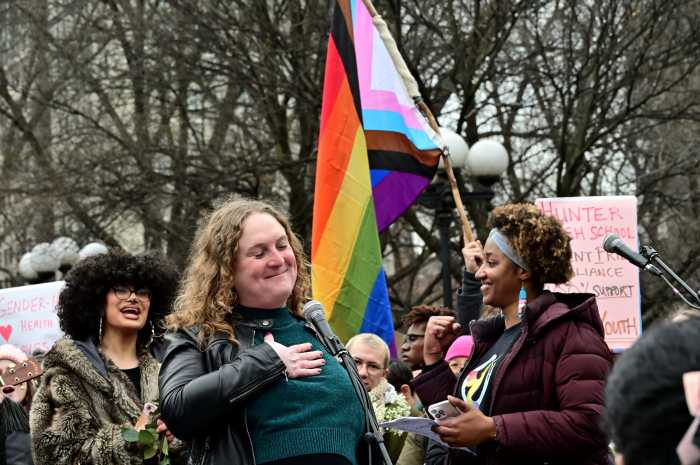After five previous delays, the 28-member Brooklyn Marine Terminal (BMT) task force, chaired by U.S. Rep. Dan Goldman and co-chaired by state Sen. Andrew Gounardes and Council Member Alexa Avilés, voted 20-8 on Sept. 22 to redevelop 122 acres of one of Brooklyn’s last remaining industrial waterfronts.
The ambitious $3.5 billion vision plan, led by the New York City Economic Development Corp., calls for a 60-acre modern all-electric port, 6,000 homes, 28 acres of new open space, more than 275,000 square feet of industrial space, resiliency measures, and dedicated areas for workforce, community and culture. The plan also projects more than $18 billion in economic impact, creating 37,000 construction jobs and 2,000 permanent jobs across maritime, industrial, commercial and residential sectors.
Protesters outside 100 Columbia St., where the vote took place behind closed doors, expressed frustration not only with the process — which they say has been marred by a lack of transparency and backroom deals — but also with Brooklyn Borough President Antonio Reynoso and Council Member Shahana Hanif. The two had been holdouts for months but flipped to yes after the EDC revised the plan last week.


In a statement, Reynoso, who was met by protesters chanting “shame” as he arrived to cast his vote, said he supported the Brooklyn Marine Terminal plan because it was a “once-in-a-generation opportunity to maximize our waterfront’s economic potential.” He noted that the plan still faces more reviews and oversight.
“To be clear, the fight for the harbor of the future is far from over. There are many decisions we will need to make, reports we will need to scrutinize, and details we will need to comb through,” Reynoso said. “A port-first plan can solve for many of the concerns raised throughout this process. It can activate our Blue Highways — keeping trucks off the streets and our air clean — while creating well-paying jobs that will allow working-class New Yorkers to stay in our beloved city.”
Hanif said that through continued collaboration with Reynoso, they were able to secure “new, critical commitments that significantly improve the plan.”
Those improvements include more than 3,650 units of affordable housing — 2,400 on-site and 1,250 off-site — as well as $3 million for local schools, $7 million for parks, a study to restore the B71 bus route, $50 million for an electric shuttle service connecting the site to nearby subway stations, enforcement of truck and commercial vehicle route restrictions to reduce traffic and pollution, and installation of two pedestrian signals near the Van Voorhees Playground on- and off-ramps.
Port developers, operators and maritime users will also have the chance to share their ideas for the site through a Request for Expressions of Interest, or RFEI.
Hanif, who has been critical of the EDC throughout the process, said that while she supported the plan, she would continue to push for “outstanding demands.”
“Transportation, resilience, and small business protections still need deeper study and action,” Hanif said in a statement. “Advancing the plan ensures those questions will be addressed through binding agreements and a transparent public process.”
Carolina Salguero, founder and executive director of the maritime nonprofit PortSide New York and a BMT tenant, said she was surprised by Reynoso’s yes vote, especially since he had been outspoken about the need to preserve and improve maritime industrial spaces.
“[Reynoso’s] decision to flip now makes no sense on the surface,” Salguero said, questioning the timing so close to the mayoral election. Mayor Eric Adams, who has supported the development, is widely expected to lose.
“When a new mayor comes in, they appoint a new president of the EDC,” Salguero said. “The mayor clearly looks like it is going to be Zohran Mamdani. He has a completely different value system about an affordable city, a city where the economy works for all, the idea that luxury housing would be put on public land to support infrastructure. That’s not what he’s about; he’s going to walk his talk. So why did [Reynoso and Hanif] cave now?”
Salguero also criticized the RFEI process.
“The EDC has burned out the maritime community in the harbor by using RFPs or RFEIs to, as they put it, test the market,” she said. “You’re asking companies to send in RFEI suggestions for what to do here, and they might not even get the contract from the get-go.”
Brooklyn resident James Morgan told Brooklyn Paper he believed Hanif, Reynoso, Goldman and Gounardes had betrayed their constituents by voting in favor of the plan. He said he fears their vote could disillusion young voters who have been energized by mayoral candidate Mamdani’s grassroots campaign.

“They have put such a blemish on the new movement in politics that we need in this city and this country,” Morgan said. “They’ve tarnished Mamdani’s mayoral run. This is going to have a trickle-down [effect] and blow back on all of them, and they should be ashamed for what they’ve done to their constituents and what they’ve done to their own reputations and what they’ve done to people’s faith in politics.”
Mayor Adams, Gov. Kathy Hochul, NYCEDC President and CEO Andrew Kimball, Goldman and Gounardes celebrated the vote as a historic day and a step toward the future.
“By approving this $3.5 billion vision plan, we will turn a crumbling marine terminal into a modern maritime port while creating thousands of affordable homes and tens of thousands of good-paying jobs. We’ll deliver the open space our city needs and keep New York at the front of the green economy,” Adams said.
But the eight task force members who voted against the measure — including Assembly Members Marcela Mitaynes and Jo Anne Simon and Council Member Alexa Avilés — said many of their concerns with the EDC’s plan were ignored.
In a joint statement, the members said the EDC pushed a “flawed” proposal without transparency, adequate studies or genuine community input, and failed to address key issues such as infrastructure, transportation, flood risk, and the promise of a “harbor of the future” providing manufacturing jobs and robust maritime opportunities.
“We participated in the BMT Task Force in good faith, hoping that our engagement would shape a forward-thinking and equitable vision for our waterfront. Our goal from the beginning had been to get to a ‘yes,’ and we remained committed to that outcome. Unfortunately, to date, many of our concerns with the EDC’s proposal for the site have gone unaddressed,” the statement read.
Mitaynes, who represents Red Hook, Sunset Park and northern Bay Ridge, told Brooklyn Paper that task force members didn’t have time to review the revised plan or share the changes with the community.

“I made a last-ditch effort to remember that this was a democratic process. I very much want to hear what other folks think about the changes. And, you know, value the opinions of folks that are experts in the room. I know my limitations, and so that wasn’t allowed,” Mitaynes said, underscoring the importance of transparency and community involvement. “The process was opaque and rushed, and I really wish that we had more opportunity to bring folks in.”
Mitaynes’ sentiment was echoed by Columbia Street Waterfront founder John Leyva, who called the vote “atrocious.” He said the amendments should have been presented to the community before the vote and voiced his disappointment in Reynoso and Hanif.
“They should have at least had one last meeting and tell the public what this great deal is that made [them] change [their] mind,” Leyva said. “They had the power, both of them, to say, ‘Well, okay, let’s say they change their vote, but we won’t do it until after you meet with the public and let the public know.’ And for them not to do that, I’m lost for words.”






















